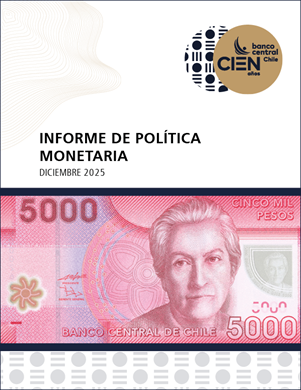Monetary Policy Report
Monetary Policy Report (IPoM)
Monetary Policy Report December 2025

Headline inflation fell faster than projected in September, in a global and local economic environment that was somewhat better than expected. In the central scenario of this Monetary Policy Report (IPoM), inflation would reach the 3% target in the first quarter of 2026. This considers a more favorable performance from some cost factors, in a context where risks to inflation convergence have diminished. Overall, local activity has been in line with expectations, with more dynamic investment in machinery and equipment. Internationally, the external boost is somewhat stronger for Chile. Global activity has been resilient to the uncertainty shocks at the beginning of the year, and financial conditions have improved. The rise in the price of copper has positively impacted the terms of trade. Nevertheless, global risks remain significant. The Board will evaluate the future movements of the Monetary Policy Rate (MPR) by considering the evolution of the macroeconomic scenario and its implications for the convergence of inflation.
What does this MP Report tell us?

De cumplirse las proyecciones, la inflación (el alza general de los precios) alcanzaría la meta de 3% en el primer trimestre de 2026.

De cumplirse las proyecciones, la inflación (el alza general de los precios) alcanzaría la meta de 3% en el primer trimestre de 2026.
- El IPC, indicador que mide la variación de los precios de los bienes y servicios, ha bajado más rápido de lo previsto en el IPoM anterior, pasando de 4% en agosto a 3,4% en noviembre.
- ¿Por qué ha pasado esto? Principalmente debido a una mejor evolución de algunos factores que influyen en los precios, como la reducción del tipo de cambio.
- Así, se proyecta que llegaría a la meta de 3% durante el primer trimestre de 2026.

La economía chilena ha seguido creciendo, destacando el dinamismo de la inversión.
- La actividad económica del país ha evolucionado en línea con lo esperado.
- En la demanda, destaca el dinamismo de la inversión en maquinaria y equipos, influida por grandes proyectos en la minería y la energía.
- Las proyecciones de crecimiento de la inversión aumentan nuevamente en este IPoM, especialmente este año y el próximo.
- De acuerdo con el IPoM de diciembre, se espera que la economía chilena crezca 2,4% este año y entre 2% y 3% en 2026.

El escenario internacional ha mejorado, pero persisten riesgos importantes que podrían afectar la economía.
- El aporte que hará la economía mundial al crecimiento de Chile es algo mayor a lo que se esperaba hace unos meses. Entre otros factores, porque el crecimiento del mundo ha mejorado y el precio del cobre subió.
- No obstante, los riesgos siguen siendo importantes y de concretarse tendrían efectos negativos en la economía mundial y la chilena.
- Uno de esos riesgos se asocia al impacto de las nuevas tecnologías —como la inteligencia artificial— en el valor de las empresas que las producen y en la economía en general, pues dicho valor podría ser menor de lo que se estima.
- Por otro lado, también hay preocupación por la deteriorada situación fiscal de varios países desarrollados, que han aumentado sus déficits y su endeudamiento.
- Además, se mantiene la preocupación por los efectos del alza de los aranceles que dispuso Estados Unidos y la reacción de otros países.

El Banco seguirá de cerca la evolución de la economía mundial y chilena, para asegurar que la inflación se mantenga baja y estable.
- En su reunión de diciembre el Consejo del Banco Central decidió reducir nuevamente la TPM, llevándola a 4,5%.
- El Consejo evaluará los próximos movimientos de la TPM considerando la evolución de la economía y sus implicancias para que la inflación se mantenga baja y estable.
